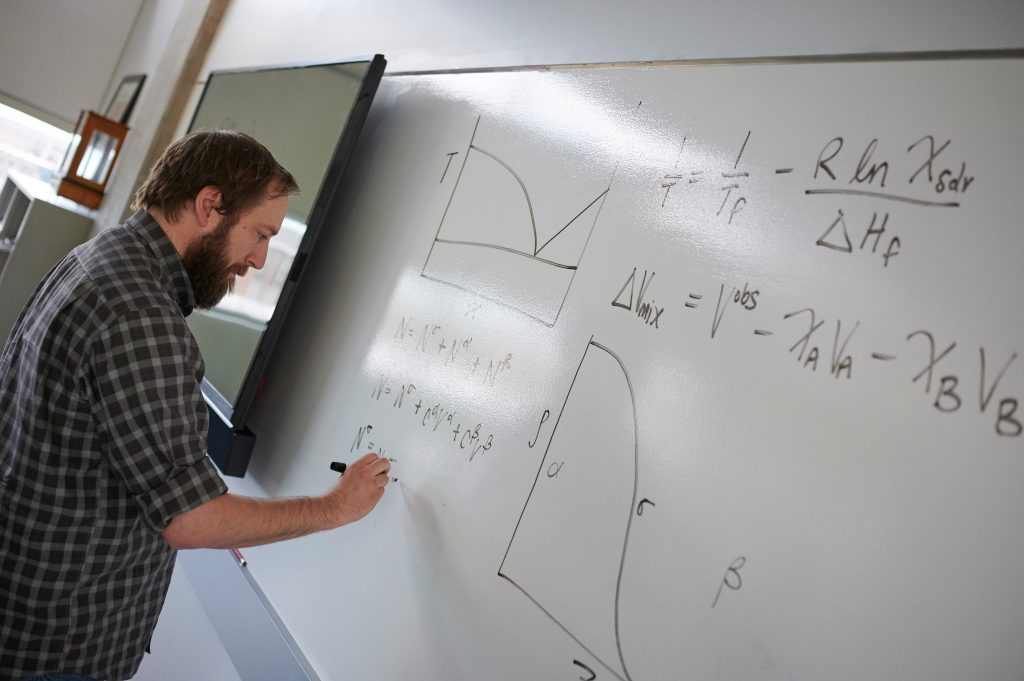July 16, 2019
Insulin, a medication used to treat diabetes, is temperature-sensitive and has a short shelf life. It can be stored unopened for up to a year, but once opened, it must be used within weeks or even days. Because insulin is composed of proteins suspended in a water-based solution that facilitates its delivery and preservation, if it isn’t refrigerated or used shortly after opening, those proteins can break down and become ineffective.
While many Americans may not consider insulin storage requirements much of a problem, diabetics who lack resources could be at high risk. According to the community health organization Partners in Health, about one out of three members of the Navajo Nation suffers from diabetes or prediabetes, and many of them live in rural areas where they may not have electricity or easy access to health care resources such as pharmacies.
To address the problem of insulin’s temperature sensitivity, Gerrick Lindberg, assistant professor of physical chemistry in NAU’s Department of Chemistry and Biochemistry, will use a $60,000 National Institutes of Health grant awarded through the Southwest Health Equity Research Collaborative to study whether ionic liquids or deep eutectic solvents could be substituted for a water solution to preserve and deliver insulin.
“Ionic liquids are salts, but unlike table salt, which remains solid to a very high temperature, they remain liquid at a wider temperature range,” Lindberg said. “We all know water changes states when temperatures vary. Ionic liquids are more stable.”
Working with his team of graduate and undergraduate students, Lindberg will test mixing insulin with these liquid salt solutions, then evaluate the mixtures for two important factors. They must ascertain whether the insulin proteins keep their shape when suspended in ionic solutions as well as or better than in water-based solutions and ensure that the proteins don’t stick together. When either of those reactions occur, the proteins are no longer bioactive and the insulin becomes ineffective. If the formulations are successful, a longer-lasting and easier-to-store medication could be on the horizon.
Lindberg is hopeful because previous work conducted with Andy Koppisch, associate professor of biochemistry, indicated that such solutions can facilitate the topical delivery of antibiotics without irritating human skin and can even enhance the medication’s effectiveness.
“One solution in particular that we are looking at, choline geranate, shows real promise,” Lindberg said. “The FDA has approved all the components of one solution, but how those components behave in the human body when they are combined needs more investigation. More FDA testing will need to take place to prove it’s actually safe. Obviously, if this works out, it has dramatic implications for healthcare and medicine.”
Improving the astronaut experience in space
Lindberg’s goals go far beyond earthly confines. If his team proves that ionic solutions are successful delivery systems for insulin and antibiotics, they may be used for other drugs astronauts may need, such as pain medications. Lindberg hopes to secure additional funding to conduct further research, and that’s why the team is planning experiments on how the mixtures will react to X-ray radiation.
“This is literally a pie-in-the-sky effort. My group is exploring materials that could stabilize medicine for extended space travel,” Lindberg said. “Because ionic liquids are pressure- and temperature-stable, they can be used in extreme environments, and space is about as extreme as you can get. They also tend to be radiation-stable, so if cosmic or UV rays hit them, perhaps they will not fall apart in the same way that organic molecules do.”
Drug expiration dates are important considerations in space because astronauts don’t have the option of going to the pharmacy. Expiration dates on the pain medication and antibiotics they may need are currently two to three years out. Lindberg hopes to extend that to about five to 10 years.
“If you run out of insulin or other medications here in the United States, there are cost concerns, but you can resupply. In space, if your supply fouls, there’s no way to replace it,” Lindberg said. “Imagine a mission to Mars. At best, you have five years before you can restock. The intrinsic properties of these solutions make them well-suited for such applications.”
Lindberg joined NAU in 2014. His research interests include water physical chemistry, astrochemistry, protein and lipid membrane biophysics, and enhanced sampling methods. His lab uses theoretical and computational chemistry to understand complex, condensed-phase systems.

Kerry Bennett and Amy K. Phillips
Office of the Vice President for Research



